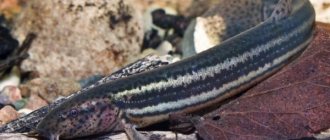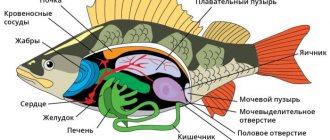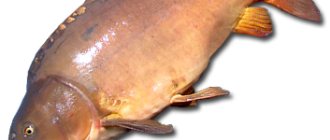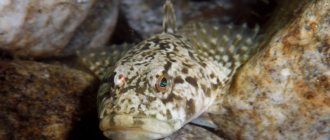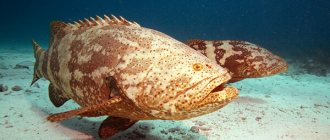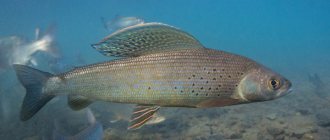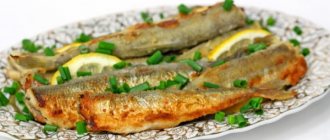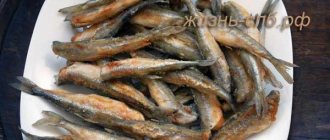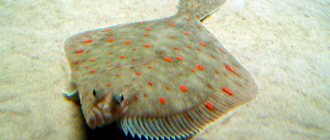Description
Smelt
Live smelt is very beautiful. Her back is brownish-green, somewhat translucent, since the dorsal scales are not lined with silvery pigment inside; the sides are silver with a blue tint on top and bottom; this silvery stripe is sometimes wider, sometimes narrower, sometimes more or less shiny (depending on the habitat), starts from the gill cover and, gradually narrowing, stretches to the base of the caudal fin; young people don’t have it at all.
This silvery color of the sides of the body depends on the pigment deposited in the skin itself, under the scales. The ventral hymen is also silvery, and on the inside of the gill cover there is a deposit of black pigment in the form of more or less dense spots. The fins of smelt are whitish, but sometimes they are lighter or darker. Males differ from females by a more prominent lower jaw, and during spawning by a larger number of warts on the head and lower paired fins. The size of this fish is insignificant: most often smelt
grows from 6 to 7 1/2 inches in height and in rare cases reaches a length of 10 inches.
Distribution and habitats
In the fishery throughout the Gulf of Finland, smelt is the second most important fish after herring. From the Gulf of Finland, smelt comes to spawn in many, although not all, rivers that flow into it: Narva, Luga, Sestra, Sista, Rokkala and others. But the Neva smelt is especially loved. In spring, smelt rise in dense schools from the Gulf of Finland to the Neva to lay eggs on the sandy bottom near the Peter and Paul Fortress and in other places upstream to the Ivanovo rapids.
Smelt habitats
In the Baltic Sea, smelt is a common fish everywhere; it is found in the North Sea, in Ladoga, Onega and some large lakes of Karelia, in each of which it forms independent herds. In many lakes there lives a small, fast-maturing dwarf form of smelt - smelt.
Smelt in the southern part of Ladoga spawns in the rivers Syasi, Svir, Olonka, and in the largest numbers in Volkhov, where it rises to the dam of the Volkhov hydroelectric station.
The modern distribution of smelt (marine anadromous, lake forms and dwarf smelt - smelt) is associated with the glacial and post-glacial history of its habitat areas. Smelt is a relic of ice age, like freshwater char, vendace, slingshot and sculpin goby. This fish is very sensitive to pollution and lives only in reservoirs with clean water. In many rivers of Western Europe, heavily polluted and with regulated flows, the number of smelt, which was once a large commercial fish there, has greatly decreased.
How to properly feed smelt
If fishing takes place in places with weak currents or in standing water, then the bait will be the same as when catching other fish. You need to add bait little by little, wait a little and cast the fishing rod.
If the current is obvious, then ordinary bait will not work; the bait will simply be carried away from the fishing spot. In this case, we need to make balls from bait, clay and sand. There should be more bait than other components. The ball will reach the bottom, will disintegrate, the particles will slowly rise up, and only then will they be blown away. But the time until the bait rises to the surface is enough to attract smelt.
Spawning
Spawning of smelt Spawning begins when the water temperature reaches 4°C, the height of spawning is at a temperature of 6-9°C.
The timing of the start of spawning in the vast range of smelt is different: in the rivers of Western Europe, smelt spawns in March and even February, in many reservoirs of Eastern Europe and North America - in April - May, on the White Sea - in May, in the rivers of Siberia - in June and even July. Smelt spawning begins soon after the ice breaks up, and sometimes even under the ice. Mass spawning usually lasts only a few days. The female spawns eggs immediately and soon leaves the spawning ground (in the White Sea smelt, the female remains on the spawning ground for only a few hours), males stay on the spawning grounds for a longer time and participate in spawning with many females, spawning milk gradually. Smelt spawn mainly at night. Smelt, rising in large numbers to spawn in small rivers and streams, becomes easy prey for predators (primarily fish-eating birds), as well as for fishing. In its rush to spawning sites and on the spawning grounds themselves, smelt loses all caution and can be caught by hand. In streams, spawning smelt are scooped out with an ordinary net. The fish spawns with noise and splashing.
Often, due to the dark backs of spawning fish, the bottom is literally invisible. During the spawning period, smelt develops a nuptial plumage: the upper part of the head and gill covers become blue-black, the lower jaw becomes sharper, the head, back and sides of the body are covered with tubercles. In females, the mating plumage is much less pronounced than in males. This has a certain biological significance: it was observed how, on a spawning ground, fish of the same sex immediately separate when they come into contact, while fish of different sexes immediately form a spawning pair. Apparently, fish of different sexes find each other using the sense of touch, and the tubercles in this case are of great importance. Smelt spawns in the current. The eggs are spawned on stones, pebbles, aquatic vegetation, washed-out roots of coastal plants, and branches of shrubs lowering into the water. Caviar is much less common on sand and never on muddy soils. The depth at the spawning grounds is usually small: from 15-20 cm to several meters. The outer shell of an egg that has fallen into the water becomes sticky and, upon contact with any object - a stone, a plant, etc., is firmly glued to it. Then an interesting phenomenon is observed: the outer shell of the swollen egg bursts, slides off the inner one and turns inside out, remaining connected to the inner shell at only one point, forming a kind of stalk. On this stalk the egg is kept attached, swaying in the water. Some eggs subsequently break off and are carried away by the water; the inverted outer shell, reminiscent of a parachute, helps to speed up the removal of the eggs. Some observations suggest that this is how dead eggs are carried away from spawning grounds. It is characteristic of smelt that the spawning grounds usually have a small area and the eggs are distributed unevenly on them, so that in some places a rather thick layer of laid eggs is formed, sometimes reaching a thickness of several centimeters (for example, in the White Sea smelt and in the smelt of some areas of North America). Many eggs die from drying out when the water level fluctuates, are destroyed by predators: insects, fish - stickleback, brown trout, gobies, in lakes - ruffe, perch, as well as the spawning smelt itself, which quite often has its own eggs in its stomachs. The larvae hatch after 15-20 days and roll downstream.
Age and size
The length of smelt does not exceed 30.7 cm, usually no more than 25 cm. Males are always smaller than females, the average length of the former is 15-16.5 cm, the latter is 16.5-18.9 cm; Males weigh on average 32 g, females 37 g.
However, these data, taken from the work of the famous Soviet ichthyologist and geographer Academician L. S. Berg, generalize information about fish from commercial catches caught in the area of river mouths or in the rivers themselves, including the Neva. With the development of amateur smelt fishing in the Gulf of Finland, information began to come in about the size of fish caught, much larger than those mentioned. Smelts 30 or more centimeters long are often found in amateur catches in the western parts of the Gulf of Finland on both its coasts, from depths of over 20 m. Such fish sometimes weigh more than 150 g. Smelt grows slowly: six-year-old fish are only 18-19 cm long, weigh 34-37 g. However, there is no direct relationship between length and weight for large specimens. So, with a length of 28 cm, some fish weigh 155.5 g, others with a length of 29 cm can weigh less than 141 g, and with a length of 25, 5 cm - only 99 g. The largest specimen of smelt known to us weighed 232 g with a length of 28.9 cm; this fish was caught near Primorsk on April 7, 1985. The record size smelt was caught in Finland in 1964: it weighed 295 g.
Types and varieties of smelt
The smelt family is quite numerous and includes several genera of ray-finned fish, including Osmerus, a genus of smelt. It consists of 4 main types, but also includes numerous subspecies and forms:
Osmerus eperlanus
This is the Latin name for European smelt. Its main habitat is the North and Baltic Seas.
Photo and description of osmerus eperlanus:
- The body is elongated, covered with relatively large, easily falling scales.
- Mouth – with strong jaws and strong teeth.
- Color: Silver scales on the sides, brownish-greenish back, colorless fins.
During the spawning period, numerous tubercles appear on the fins and head of the fish. Unlike the Asian toothed smelt, the European toothed smelt has significantly weaker teeth and a shorter lateral line.
Smelt
Osmerus eperlanus is often found in rivers and lakes of Scandinavia, in the northwestern part of Russia.
When living in closed water spaces, its species degeneration occurred. Today, the freshwater, “dwarf” form of European smelt is better known as smelt and is of great commercial importance. The length of some specimens can reach 18 cm, but most often does not exceed 10 cm, weight - 6-8 g. Special external differences of the smelt fish are as follows:
- The back is dark and has a grey-green tint.
- The scales on the sides are silvery and the scales on the belly are whitish.
- The edge of the caudal fin is decorated with a dark border.
Catching smelt
Catching smelt The main catching of smelt is carried out during its spring movement: in the Neva with special nets - merezhs, in Lake Onega, at the mouths of rivers - with large seines, and in rivers - with nets stretched on a number of stakes, which are driven in starting from the shore, not across rivers, but at an acute angle. In Lake Ladoga, in addition to spring fishing in the rivers, after they have opened, smelt is also caught in the summer (in the northern part of the lake) with large seines. In the White Sea, the main fishing for this fish is carried out at the beginning of winter - before Christmas, near the shores, with three-walled nets (up to 20 fathoms long and no more than two arshins wide), in which it becomes entangled. In addition, along the shores of the White Sea, a significant amount of smelt is caught by fishing, which is done here mainly by women, old people and teenagers. They fish for smelt on the ice almost throughout the winter, but mainly in February and March. To a short (about 6 vershok) and narrow (in vershok) board (plier), replacing a fishing rod, with cutouts for winding the line, a hairline of 2-3 fathoms in length with a lead sinker 1 1/2 vershok long and 3/3 in diameter is tied 8 inches. A “overweight” is threaded through the lower end of the sinker - a wire (or a thin iron stick) 3 inches long, to the ends of which fairly large hooks without bending are tied on hair leashes (thin ones) 3 inches long (i.e., a sting and a rod in one plane) and with a sting bent outward. Sometimes the weight itself is the sinker itself, which is given the shape of a gentle arc; in this lead bow (tied in the middle) 3 to 5 holes are made, into which thin hooks are threaded. The bait is a small piece of fish (navaga, smelt, small herring, loach or whitefish), the baited hooks are lowered through the hole (up to half an arshin in diameter) so that they stand at half-water (the smelt is kept far from the bottom), and the glue is placed across the hole or they press it with a flyer stuck in the snow. Usually two scaffoldings are lowered into one hole. From time to time, by tugging on the glue, the fisherman finds out whether a fish has been caught; in the latter case, he quickly pulls out the line and, with a blow to the head with a small stick or simply hitting the ice, releases the hook and lowers the line into the hole again. In the same way (since February) smelt is fished in the southern parts of Lake Ladoga (for smelt pieces), but here only with good fishing it is possible to catch up to 300 pieces per day.
Dried Far Eastern smelt
This is a favorite treat for men with beer. Let's consider the simplest recipe so that extra flavors do not interrupt the main one.
- Pour water into a container and add salt well. Determine the amount of salt using peeled potatoes. Place it in water, add salt little by little, stirring constantly. The potatoes have floated - there is enough salt.
- Next, add soy sauce (for 12 liters of water - 320 milliliters of sauce).
- Place the fish in the sauce, cover with a weight (5-6 kilograms).
- After five hours, add a tablespoon of vinegar.
- After an hour, remove the fish, rinse well under running water, and leave for an hour to drain.
- After this, the carcasses need to be rinsed in slightly sweetened water and allowed to drain again.
- You should hang the fish only in a well-ventilated area.
So, we have looked at the simplest and most popular recipes for preparing Far Eastern smelt, now let’s see why it should be eaten.
Smelt in cooking
When smelt is fresh, it has a specific aroma, reminiscent of the smell of fresh cucumbers.
The meat of this fish is fatty, so it is suitable for both frying and more gentle cooking methods. The most popular, classic, simple and most delicious way of cooking fresh smelt is, of course, frying. After all, in order to fry smelt, it is enough to clean each fish, removing the insides, roll in flour and fry in oil. Although smelt is covered with fairly large scales, it is very easy to clean. This fish can also be smoked, marinated, baked, stuffed, grilled, or stewed in white wine. Fish soup is also made from it, and fish oil is produced in Scandinavian countries. Smelt makes excellent canned food. This fish is perfectly stored frozen, for which it is cut up, washed and stored in the freezer.
In St. Petersburg, for example, hot smoked smelt, which has excellent taste, is very popular.
In stores you can buy frozen, chilled, salted and smoked (smoked) smelt.
Fishing for smelt
The time of year favorable for catching this species depends on your habitat. In St. Petersburg this is, for example, February, but in other cities it is most often the end of January.
Choosing fishing gear is quite simple. Since the fish is light and often encountered, it is enough to simply choose gear that is convenient. You can even make them yourself. The whole point is simply to easily catch fish and enjoy the process, which is so simple in this regard, and does not require special expenses or special equipment.
The only advice that experienced fishermen give is not to take a thick line or too hard, as it will get tangled and twisted, interfering with the process. This gear should also be changed every season due to its constant contact with low temperatures.
Fishing spots, where to look for smelt?
Since it is best to catch smelt in winter, when the water surface is already covered with ice, it is easiest to search for its habitat with an echo sounder. The fish lives above the deepest depressions and holes with a sandy or clay bottom. However, it stays in the middle layers of the water surface.
Is it only in salt water that smelt are caught?
Of course not. During spawning, smelt can migrate to both salt and fresh waters. In the end, she goes to the Neva to lay offspring.
How to catch smelt and what bait does it bite on?
This type of fish does not pick at baits and getting it interested is not a difficult task. You can throw an almost empty hook and the fish will still react to your attack not in its favor.
However, if you really want to achieve results and make your fishing as productive as possible, then it is worth remembering that smelt responds best to bait made from organic substances, in other words, from the same fish or animals. She will happily bite on seafood, fish from fresh or salt waters, as well as worms or maggots.
In general, catching smelt is labor-intensive work, since no fisherman will be satisfied with just one fish, and fishing for it requires a quick reaction and a high level of dexterity. However, if you are sufficiently trained and resilient, then you will like this type of fishing.
There are several little secrets that experienced fishermen give:
- It is better to look for smelt in places where people are a rare guest, or at least where there are very few people. This fish does not like noise and the accumulation of living organisms that produce it.
- Although it is found in areas near deep water holes, it does not like changes in depth around it.
- Install about a dozen fishing rods at once;
- Place them in a checkerboard pattern;
- You can also place it diagonally.
Fishing for smelt in St. Petersburg
In St. Petersburg, you should catch smelt around February, then the catch will be large-scale. However, the individuals at this time are not too large, but a catch of half a thousand pieces will weigh half a dozen kilograms.
Rating: 5 1 votes
When people talk about smelt, the majority of the population of our country immediately thinks of St. Petersburg, the Gulf of Finland and the Neva, where a crowd of St. Petersburg fishermen enthusiastically hunts for fish that smells like fresh cucumbers. However, few people know that this tasty fish has many relatives in other regions.
We will talk about the types of smelt, in what habitats they are found and what their way of life is, about catching this tasty fish and much more that is somehow connected with it in today’s report.
